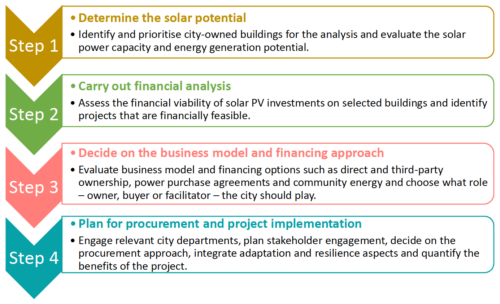
A solar feasibility study is the first essential step in creating a successful solar energy project. The study examines if the solar array is financially and technologically viable. It also determines if the solar project gets the green light by identifying roadblocks in the beginning of the planning phase.
There are many essential factors to consider, such as location, proximity to utilities, net metering laws, site layout, energy storage potential, and cost, to name a few. It is vital to have a basic understanding of your project’s financing, interconnection challenges, solar equipment compatibility, local regulations, permitting requirements, and the solar radiation. These reports are usually intended for building, business, or landowners and are often used with grant applications. It is one of the first steps in the project development process.

The goal is to limit project risk and address issues early. When identified, many critical design constraints can be overcome effectively with planning. Without a thorough feasibility analysis, solar power system installations are more likely to go over budget or get stalled.
It entails conducting a site inspection (when necessary), selecting the preliminary solar components, and making basic electricity production estimates. For large or complex solar PV installations, this process can be involved and time-consuming, especially when there are numerous solar design constraints and financing options. We’ll touch on the most common things to include in a feasibility study below.
It is crucial to understand the context for the project, such as the owner’s goals and desired outcomes. These factors drive the preliminary design process and help inform decisions, like whether or not to add a solar battery bank to an installation.
The potential site has numerous implications on the solar energy system, project viability, system performance, maintenance costs, and installation costs. For ground mounts, the topography will indicate if site work needs to be done and could impact the tilt angle of the PV panels. The site selection dictates if the land needs to be cleared, adding to the cost and environmental impact. Likewise, the location indicates what regulations impact the permitting fees and engineering process, building codes, and utility interconnection.
Feasibility studies include recommendations on solar PV panels, racking, inverters, and battery storage equipment (when applicable). Often, site conditions influence the options for a given solar power project.
For example, if a site has low roof load limits, you might install a racking system that evenly distributes the weight and wind load of the system. Solar power generation on white roofs might be improved by using bifacial solar panels. Inverter selection may vary depending on whether the solar photovoltaic system has batteries.
Solar regulations vary by building codes and the Authority Having Jurisdiction (AHJ). Solar farms must comply with federal and state environmental policies, and relevant federal statutes may include the National Environmental Policy Act (NEPA), the Clean Water Act, and the Endangered Species Act. If a solar farm is installed on a capped landfill, the Environmental Protection Agency will be involved.
There are also ways to mitigate the environmental impact of the project during its operation. For example, planting drought-tolerant native wildflowers may reduce the irrigation requirements of the site and establish pollinator habitat.
Understanding the financial implications of a solar installation is crucial for calculating the return on investment and reducing financial risk. Often, investors or owners need this information to determine if a project is financially viable. The economic analysis examines the project costs and revenue potential through renewable energy generation, tax and other financial incentives.
It is vital to consider local and federal financial incentives, such as the investment tax credit, bonus depreciation, and MACRS depreciation. In some cases, local incentives or grants might be available, such as state clean energy rebates or the REAP grant (for agricultural producers or small businesses in rural areas). Some businesses pay demand charges for their energy use and it is crucial to understand how installing a solar PV system would impact the cost of energy. If a Power Purchase Agreement (PPA) is involved, it is critical to understand how its terms impact the economics of the project.
Solar photovoltaic installations do not happen in a vacuum. A commercial solar project may boost a company’s reputation by taking actions to mitigate climate change. Large-scale solar farms can have a bigger impact, both financially and environmentally. Such projects can increase tax revenue in a community and compensate landowners with lease payments. Many local governments and communities support reducing their reliance on fossil fuels and promoting energy efficiency.
Likewise, taking farmland out of production or destroying wildlife habitat may be concerning to some communities. There is also a concern in some communities about creating local jobs instead of bringing in out-of-state solar installers.
The vast majority of solar installations benefit from a feasibility analysis to ensure that the proposed project realizes the project goals. The depth of the study varies by the project size, potential issues, and stakeholder demands.
A thorough and accurate feasibility study lays the foundation for a successful solar energy installation project. They are an excellent way for reputable companies to differentiate themselves by ensuring that all key stakeholders are well informed and that critical design constraints have been identified.
BCSC LLC can procure a solar feasibility study for your project. Inquire today by calling 310-499-3658 or through the contact us button below!